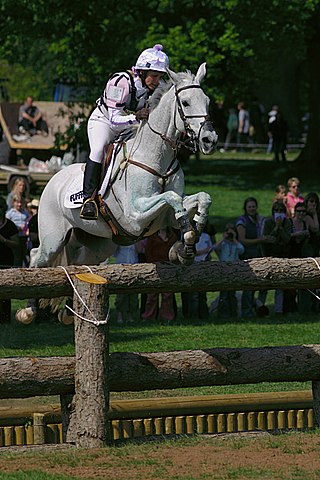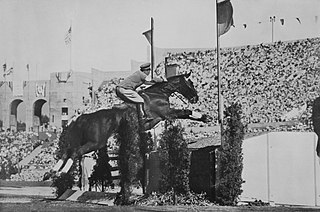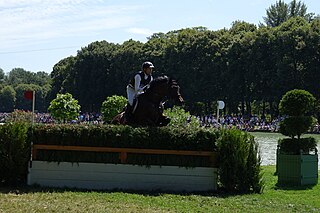Show jumping is a part of a group of English riding equestrian events that also includes eventing, hunters, and equitation. Jumping classes are commonly seen at horse shows throughout the world, including the Olympics. Sometimes shows are limited exclusively to jumpers. Sometimes jumper classes are offered in conjunction with other English-style events. Sometimes, show jumping is but one division of a very large, all-breed competition that includes a very wide variety of disciplines. Jumping classes may be governed by various national horse show sanctioning organizations, such as the United States Equestrian Federation or the British Showjumping Association. International competitions are governed by the rules of the International Federation for Equestrian Sports.

Eventing is an equestrian event where a single horse and rider combine and compete against other competitors across the three disciplines of dressage, cross-country, and show jumping. This event has its roots in a comprehensive cavalry test that required mastery of several types of riding. The competition may be run as a one-day event (ODE), where all three events are completed in one day or a three-day event (3DE), which is more commonly now run over four days, with dressage on the first two days, followed by cross-country the next day and then show jumping in reverse order on the final day. Eventing was previously known as Combined Training, and the name persists in many smaller organizations. The term "Combined Training" is sometimes confused with the term "Combined Test", which refers to a combination of just two of the phases, most commonly dressage and show jumping.

The equestrian program at the 1912 Summer Olympics in Stockholm, included five medal events. There were individual competitions in dressage, eventing, and show jumping. Team scores were also gathered and medals awarded for teams in the eventing and jumping competitions. Equestrian had been absent from the Olympic program since the 1900 Summer Olympics, making the 1912 Games the second time the sport was featured. Ten nations competed: Belgium, Chile, Denmark, France, Germany, Great Britain, Norway, Russia, Sweden, and the USA. Only Sweden and Germany were able to supply a full team for all three disciplines, with several countries having several riders and horses used in two or even all three disciplines. A total of 88 entries ran in the three events, with 62 riders and 70 horses.

Equestrian sports were first included in the Olympic Games in the Summer Olympics of 1900 in Paris. They were again included in 1912, and have been included in every subsequent edition of the Games. Currently, the Olympic equestrian disciplines are dressage, eventing, and show jumping. In each discipline, both individual and team medals are awarded. Since the XV Olympiad in Helsinki in 1952, women and men compete on equal terms.

France competed at the 1912 Summer Olympics in Stockholm, Sweden. 119 competitors, 118 men and 1 woman, took part in 66 events in 13 sports.
The individual eventing (Military) was an equestrian event held as part of the equestrian at the 1912 Summer Olympics programme. It was the first appearance of the event.

Obstacle jumping was one of five equestrian competitions held in late May and early June 1900 at the International Horse Show in Paris. The event was part of the Exposition Universelle, and later classified as part of the 1900 Summer Olympics. It was similar to the modern show jumping event. 45 competitors entered, though only 37 competed, with some information unknown. The event was won by Aimé Haegeman of Belgium, with his countryman Georges Van Der Poele taking second and Louis de Champsavin of France in third.

The individual show jumping event was part of the equestrian programme at the 1920 Summer Olympics. The competition was held on 12 September at the Olympisch Stadion in Antwerp. There were 25 competitors from 6 nations. The event was won by Tommaso Lequio di Assaba of Italy, with his teammate Alessandro Valerio earning silver. Carl Gustaf Lewenhaupt of Sweden took bronze. They were the first medals in individual jumping for both nations.

The International Modern Pentathlon Union, commonly known by the acronym UIPM, has been the international governing body of modern pentathlon since its foundation in London in 1948. Its headquarters are in Monaco and it has 115 national federation members in 2018 and 133 members in 2024. Modern pentathlon was introduced at the fifth Olympiad in Stockholm, Sweden, in 1912, comprising the contemporary sports of pistol shooting, fencing, swimming, horse riding and running, which embraced the spirit of its ancient counterpart.

The individual show jumping was one of five equestrianism events on the Equestrian at the 1924 Summer Olympics programme. The competition was held on Saturday 27 July 1924. 43 riders from 11 nations competed. Nations were limited to four riders each; the team jumping event used the same results as this competition, with the top three individual scores counting for each national team. The individual event was won by Alphonse Gemuseus of Switzerland, with the nation winning its first victory in its debut in the individual jumping event. Tommaso Lequio di Assaba of Italy became the first person to win multiple medals in the event, taking silver to add to his 1920 gold. Adam Królikiewicz earned Poland's first individual jumping medal with his bronze.

The individual show jumping at the 1928 Summer Olympics took place on 12 August 1928 at the Olympic Stadium in Amsterdam. Scores from the individual competition were summed to give results in the team competition. There were 46 competitors from 16 nations. Each nation could send a team of three riders; 15 nations did so, while Japan had a single rider. The event was won by František Ventura of Czechoslovakia, the nation's first medal in individual jumping. France earned its first medal in the event since 1912 with Pierre Bertran de Balanda's silver. Charles-Gustave Kuhn took bronze, putting Switzerland on the podium for the second consecutive Games.

The individual show jumping in equestrian at the 1948 Summer Olympics in London was held at the Wembley Stadium on 14 August. The competition consisted of a single round of jumping. In the case of a tie in points, a jump-off was arranged. The jump-off had no time limit, however, the time taken to complete the jump-off was used as a tie-breaker. The points from the individual competition were also used in the team competition. There were 44 competitors from 15 nations, with nations able to send up to three riders each. The event was won by Humberto Mariles of Mexico, with his teammate Rubén Uriza taking silver at the top of a three-way jump-off for second place. Mariles' win was Mexico's first victory in the event. Jean-François d'Orgeix of France earned that nation's first individual jumping medal since 1928 with his bronze.

The individual show jumping in equestrian at the 1932 Summer Olympics in Los Angeles was held on 14 August. The event was called the "Prix des Nations" at the time. There were 14 competitors from 4 nations.

The individual eventing event at the 2020 Summer Olympics is scheduled to take place from 30 July to 2 August 2021 at the Baji Koen and Sea Forest Cross-Country Course. Like all other equestrian events, the eventing competition is open-gender, with both male and female athletes competing in the same division. 65 riders from 29 nations are expected to compete.

The individual show jumping event at the 2020 Summer Olympics is scheduled to take place on 3–4 August 2021 at the Baji Koen. Like all other equestrian events, the jumping competition is mixed gender, with both male and female athletes competing in the same division. 75 riders from 35 nations are expected to compete.

The team eventing event at the 2020 Summer Olympics is scheduled to take place from 30 July to 2 August 2021 at the Baji Koen and Sea Forest Cross-Country Course. Like all other equestrian events, the eventing competition is open-gender, with both male and female athletes competing in the same division. 45 riders from 15 nations are expected to compete.

The team show jumping event at the 2020 Summer Olympics took place on 6–7 August 2021 at the Baji Koen. Like all other equestrian events, the jumping competition was open-gender, with both male and female athletes competing in the same division. 60 riders from 20 nations competed. The event was won by team Sweden, which included Peder Fredricson, the silver medalist in the individual event. The United states were second, and Belgium third.
The individual eventing in equestrian at the 1936 Olympic Games in Berlin was held on the May Field (dressage), in Döberitz (cross-country), and at the Olympiastadion (jumping) from 13 to 16 August. Of the 50 horse and rider pairs to begin the competition, only 27 finished. Three horses died during the competition.

The individual show jumping in equestrian at the 1936 Olympic Games in Berlin was held at the Olympiastadion (jumping) on 16 August. The competition was also referred to as the "Prix des Nations." There were 54 competitors from 18 nations, with each nation having a team of three riders. The results of the individual event were used for the team jumping event as well. The individual event was won by Kurt Hasse of Germany, the nation's first victory in individual jumping and first medal in the event since 1912. Romania and Hungary each earned their first individual jumping medals, the former with Henri Rang's silver and the latter with József von Platthy's bronze.

The individual eventing event at the 2024 Summer Olympics is scheduled to take place from 27 July to 29 July 2024 at the Château de Versailles.
















